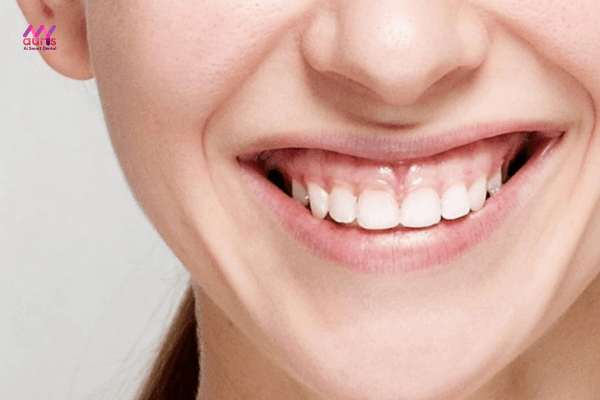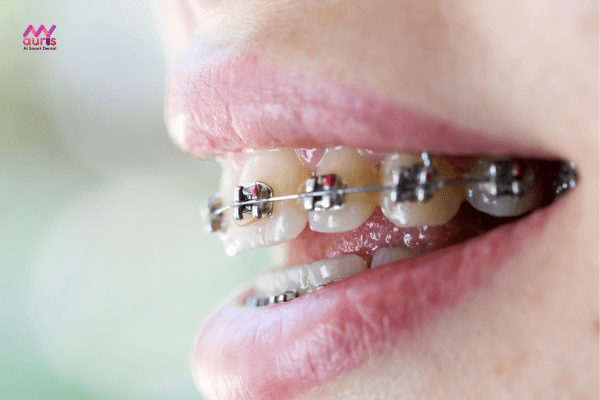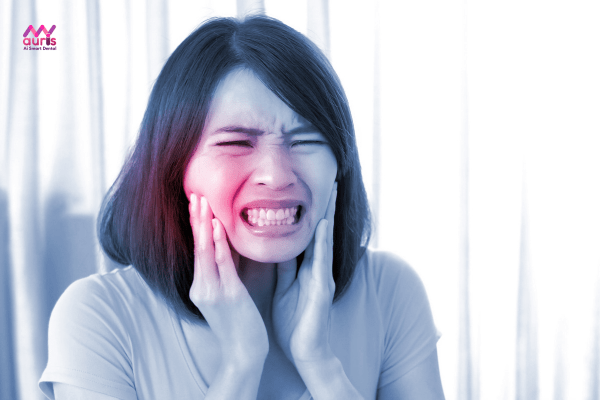Although braces are a solution to bring aesthetics, standard bite and harmonious face, there are still some cases of broken braces. This is not only unsightly but also causes many effects and complications for oral health. To learn how to recognize broken braces, let’s learn with My Auris dentistry through the following article.
How to recognize broken braces through 7 cases
Depending on the condition as well as the cause, different tooth decay occurs. Here are 7 common cases of broken braces as well as how to recognize them that everyone needs to know:
Tooth roots pop out of the jawbone, root resorption
Tooth roots are usually located in the center of the jawbone. For people with thin jawbones, the tooth roots are located outside or inside. If you have dental phenomena such as bone windows or congenital defects, you need to notify your doctor first when getting braces because the teeth will move more slowly or more seriously than other people.
When braces are used, the tooth root pops out of the jawbone often due to too much force on the tooth, the biomechanics of moving the tooth is incorrect, leading to the tip or neck of the tooth being pushed out of the jawbone. In this case, if the condition is mild, the torque direction can be changed to rotate the tooth root again, but in cases where the tooth root bone has been lost, it cannot be saved.

How to recognize broken braces in this case:
When touching the root The tooth corresponds to the outer tip of the jawbone. Sometimes you will feel the tooth root lying outward, but when you touch it, the feeling will not be accurate. Therefore, the most accurate thing to do is to have it photographed and examined by a doctor.
Tooth root bone resorption means the tooth root is shortened in length compared to before braces. The mild condition will not affect future teeth in the jaw.
Misalignment of the face, philtrum and midline
The braces process will apply force to help the teeth move to the correct position. Not only that, it is also necessary to keep a straight line with the face, that is, the midline of the two upper incisors coincides with the philtrum, the tip of the nose and the glabella point on the face. When the axis of these points is straight, the bite will be balanced, the teeth will be even and the face will become harmonious. N
The way to recognize this condition is easy to observe with the naked eye because of the unevenness, misalignment and the above mentioned points not lying on a straight line.
However, for people with congenital misalignment, misaligned noses, misaligned faces, or lower jaw bones of different lengths, orthodontics will not be able to change it because orthodontics refers to the process by which the teeth move and realign the teeth.
How to recognize broken braces: gummy smile, teeth curled inwards
Condition This is quite common and causes poor aesthetics. The cause of a gaping smile after braces is because when pulling the teeth, the force pulling the front teeth back is not well controlled, the biomechanics of moving the teeth are not effective, causing the upper jaw to move both back and down. Therefore, leading to a deep bite, curled teeth and a gummy smile. This condition in some people is even less aesthetically pleasing than before treatment.
Recognition is also easy with the naked eye when smiling, talking, communicating, and eating. With this condition, the doctor fixes it by wearing braces and sinking the entire upper jaw bone or partially sinking the tooth block before it becomes crooked.

However, most importantly, doctors must ensure control of traction when closing the space by correcting it. Post-treatment treatment takes quite a while. This time period is almost like performing a new orthodontic treatment.
The teeth do not move forward but move at an angle, causing the bite and chewing to become unstable.
The most optimal tooth movement in orthodontics is to move translationally on the jaw and crown to create a straight axis with the tooth root coinciding with the chewing force transmission axis of the two chewing planes of the upper and lower jaw. This result helps the bite to stabilize and perform the best chewing function.
The main cause of this condition is tooth tilting which is a rolling effect, when the doctor uses string elastic to close the space on the round wire, the soft wire is not stable enough.
How to recognize broken braces in this situation: when observing the mouth, you will see the teeth tilting into the gap, not the entire tooth crown moving forward to fill it.so much space.
Remedy: The doctor will have to rebuild the tooth axis and close the gap according to a different force setting system.
Particular attention needs to be paid to overcome this situation. In many cases, the doctor will have to accept a tilted tooth junction, because the jawbone at that position is too stiff, making it difficult to move the teeth.
Braces due to broken brackets
Braces use brackets, wires, and supporting devices to apply force to straighten teeth to the correct position on the jaw. Installing braces is very important and determines the success of orthodontics. If just one brace is too tight, it will affect the entire treatment process.

Gum recession after braces – How to recognize braces Broken teeth
Gum recession is also an easy-to-observe condition if braces are broken. Gum recession is also quite common when braces fail.
Sometimes gum recession is also related to applying excessive force and moving the teeth, especially tilting the front teeth outward, causing them to protrude or rotate.
How to fix: The doctor evaluates and recommends a suitable solution, which could be a gum graft, tissue regeneration or reactivating the brace to turn the tooth’s root inward to make treatment more convenient.
Many cases of gum recession with tooth roots being removed from the jawbone due to lack of control over the force of the appliance will require new teeth to be implanted.
Remedy: in cases where the two jaws cannot be aligned after braces, or if there is a problem with the temporomandibular joint, an occlusal doctor can adjust and treat to regain a stable musculoskeletal position, then braces will be performed according to this new relationship. This process takes a long time and treatment is difficult. For teeth with dead pulp, they need to be removed and treated to preserve the original tooth, then control the forcebraces, be careful with these teeth.

Hopefully with how to recognize broken braces in the article, it will help everyone understand broken braces condition. From there, recognize and correct promptly to avoid affecting oral health. Please contact My Auris Dental immediately for the most detailed advice and answers.
Anh Thy





